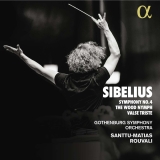Santtu-Matias Rouvali und das Gothenburg Symphony Orchestra stellen das vierte Album ihres Sibelius-Zyklus vor. Das Hauptwerk ist die 1911 uraufgeführte Vierte Symphonie, die ein Kritiker mit Barkbröd verglich, einer Baumrinde, die von den Finnen in Zeiten der Hungersnot gegessen wurde.
1908, ehe Sibelius mit der Arbeit an der Symphonie begann, war ihm mit nicht weniger als zwölf Eingriffen ein Tumor im Hals entfernt worden, und er musste seine besten Freunde, Alkohol und Tabak, meiden.
Rouvali gelingt es in fesselnder Weise, der kargen Instrumentation Substanz zu geben, die Spannung kontinuierlich aufrecht zu erhalten und dennoch den quasi asketischen Charakter der Musik nicht zu verfälschen. Dabei pflegt er die Farben und die Transparenz, so dass ein faszinierendes Klangbild entsteht.
Jean Sibelius hat unter der Opus-Nummer 15 drei Werke mit dem Titel Die Waldnymphe vereint. Alle drei sind von einem Gedicht des Schriftstellers Viktor Rydberg inspiriert und enthalten dasselbe thematische Material: so gibt es ein Klavierstück, ein Melodram für Erzähler, Klavier, zwei Hörner und Streicher und die Ballade für Orchester, die Santtu-Matias Rouvali auf diesem Album dirigiert. Das romantische Stück mit seinen manchmal exotischen Farbtönungen ist in einer sehr stimmungsvollen und spannungsgeladenen Interpretation zu hören, die erneut auch das hohe Niveau des Orchesters aus Gothenburg unterstreicht.
Auch die Valse Triste weiß der suggestiv dirigierende Rouvali in einer sehr inspirierten und rhythmisch pointierten Interpretation zu gestalten.
Er erzielt mit einer deutlichen Kontrastierung der Tempi eine erstaunliche Wirkung. Das traurige Thema wird düster, doch durch eine Beschleunigung wird der Geistertanz so dargestellt, wie ihn sich Sibelius vorgestellt haben mag, oder wie er zumindest der kleinen Szene entspricht, die der Komponist illustrieren wollte: die alte Frau, die sich vom Sterbebett erhebt, um mit Geistern zu tanzen.
Santtu-Matias Rouvali and the Gothenburg Symphony Orchestra present the fourth album in their Sibelius cycle. The main work is the Fourth Symphony, premiered in 1911, which one critic compared to Barkbröd, a tree bark eaten by the Finns in times of famine.
In 1908, before Sibelius began work on the symphony, he had undergone no less than twelve operations to remove a tumor from his throat and had to avoid his best friends, alcohol and tobacco.
Rouvali succeeds in a captivating way in giving substance to the sparse instrumentation, maintaining the tension continuously and yet not distorting the quasi ascetic character of the music. At the same time, he cultivates the colors and transparency, creating a fascinating sound.
Jean Sibelius brought together three works entitled The Forest Nymph under opus number 15. All three are inspired by a poem by the writer Viktor Rydberg and contain the same thematic material: there is a piano piece, a melodrama for narrator, piano, two horns and strings and the Ballade for orchestra, which Santtu-Matias Rouvali conducts on this album. The romantic piece with its sometimes exotic shades of color can be heard in a very atmospheric and suspenseful interpretation, which once again underlines the high level of the Gothenburg orchestra.
Rouvali, who conducts suggestively, also knows how to shape the Valse Triste in a very inspired and rhythmically pointed interpretation.
He achieves an astonishing effect with a clear contrast in tempi. The sad theme becomes somber, but by speeding it up, the ghostly dance is depicted as Sibelius may have imagined it, or at least as it corresponds to the small scene the composer wanted to illustrate: the old woman rising from her deathbed to dance with ghosts.
























